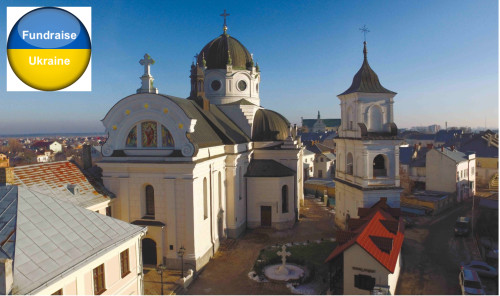
Zhovkva. The Basilian Monastery and the Church of the Sacred Heart of Christ
The complex of the Basilian monastery consists of the Church of the Sacred Heart of Christ (1612-1905, formerly the Church of the Nativity and the Holy Trinity), monastic cells (1782), a bell tower (1770), and a printing house. The church acquired its modern appearance after the 1903 reconstruction designed by Edgar Kovacs.
The monastery of St. Basil the Great was a religious and cultural center in Galicia. In 1895, a printing house and a publishing house of theological and popular literature were founded here. In 1901, the church was rebuilt, and in 1935 new wall paintings were added by Julian Butsmaniuk, a famous Ukrainian monumentalist and creator of a new artistic concept, the Ukrainian Secession, who combined religious themes and events from real Ukrainian history.
Since 1990, the church has been a functioning church of the Ukrainian Greek Catholic Church.
In 2002, during the renovation of the monastery and church, the Basilians of Zhovkva found more than two hundred skeletons, including 45 children's skeletons. An examination proved that these people were tortured by the Soviet authorities in the postwar period. After all, in the second half of the 1940s, the former monastery housed the headquarters of the NKVD for some time, whose employees exterminated the population at a "Stakhanovian" pace. Now these victims of Soviet terror are reburied in the city cemetery.
Жовква. Монастир отців Василіян та Храм Пресвятогог Серця Христового
Комплекс Василіанського монастиря складається з церкви Серця Христового (1612-1905 рр., кол. Різдва Господнього та св. Трійці), монастирських келiй (1782 р.), дзвiниці (1770 р.) та друкарні. Сучасного вигляду храм отрмав після реконструкції 1903 року, виконанаої за проєктом Едґара Ковача.
Монастир чину св. Василія Великого був релігійним та культурним осередком у Галичині. У 1895 р. тут було засновано друкарню, видавництво богословської та популярної літератури. У 1901 р. церкву було перебудовано, а в 1935 р. додано нові настінні розписи відомого українського художника-монументаліста, творця нової художньої концепції — української сецесії, Юліана Буцманюка, який поєднав у них релігійні сюжети та події з реальної української історії.
З 1990 р. церква є діючим храмом Української Греко-Католицької Церкви.
У 2002 році під час ремонту монастиря і храму, жовківські василіани знайшли понад двісті скелетів, у тому числі 45 дитячих. Проведена експертиза довела, що ці люди були закатовані радянською владою в післявоєнний час. Адже в другій половині 1940-х років у колишньому монастирі певний час був розташований штаб НКВС, працівники якого знищували населення «стаханівськими» темпами. Зараз ці жертви радянського терору перепоховані на міському цвинтарі.
Shipping is extra.
Local pickup is available in the Toronto, Ontario area.
Taken 2019
Photo Printed on Canvas,
DJI Phantom 4 Pro
Fundraise Ukraine is backed by the Mentor Family Network Organization (MFNO). A federally registered charitable organization (732632203 RR0001)) whose team is dedicated to providing aid and assistance and settlement services for refugees and those seeking asylum in Canada.
info@fundraiseukraine.ca
info@mfno.org.